Facial Hyperpigmentation
Facial hyperpigmentation is one of the most common skin conditions affecting millions of individuals worldwide. It often appears as spots or patches of skin that are darker than the natural skin tone. Hyperpigmentation can develop due to several underlying causes but is most commonly seen in sun-exposed areas of the face and chest. This condition can impact individuals of all ages and skin tones. Although hyperpigmentation is benign, it can affect one’s self-esteem, prompting many to seek cosmetic treatment. Fortunately, numerous non-invasive treatment options are available, including chemical peels, Cosmelan, Mesopeels, skin resurfacing lasers, and topical skincare products. If you are experiencing hyperpigmentation, post-inflammatory hyperpigmentation, melasma, sun spots, solar lentigines, or dark spots, board-certified cosmetic dermatologist Dr. Michele Green in NYC is here to assist you.
Hyperpigmentation is a broad term that describes various skin conditions causing discoloration due to multiple factors. It occurs from an overproduction of melanin in concentrated cells of the skin, produced by melanocytes (the cells responsible for melanin). Even with regular sunscreen application, sun spots, age spots, hyperpigmentation, and melasma can sometimes seem unavoidable. The causes and treatment options vary depending on the type of hyperpigmentation present. Common contributors include sun damage, inflammatory acne, and hormonal changes. Additionally, some patients might develop hyperpigmentation as a side effect of treatments like Fraxel laser, Intense Pulsed Light (IPL), or Picosure lasers. Therefore, consulting with an expert in facial hyperpigmentation, such as Dr. Michele Green in New York, is crucial to determine the best treatment options for diminishing and eliminating your hyperpigmentation.
Dr. Green boasts over 25 years of experience in treating facial hyperpigmentation using top noninvasive cosmetic procedures and skincare products. At her private dermatology office on the Upper East Side, Dr. Green has assisted thousands of individuals with hyperpigmentation across various skin tones and types. By combining noninvasive in-office cosmetic treatments with high-quality specially formulated skincare from her MGSKINLABs line, Dr. Green provides her patients with a customized treatment plan that addresses both body and facial hyperpigmentation. She prides herself on understanding the unique needs and goals of each patient, helping them feel and look like the best version of themselves. It’s no surprise that she consistently ranks among the top dermatologists in NYC, as recognized by the New York Times, New York Magazine, and Castle Connolly. When you consult with Dr. Green at her private dermatology office in Manhattan’s Upper East Side neighborhood, she will collaborate with you to create a treatment plan tailored to your skin type, specific needs, and skin tone, ensuring a healthy, clear, radiant complexion that endures.
What is melasma?
Melasma is a skin condition commonly characterized by brown or blue-gray patches. Several factors contribute to melasma, but the two primary causes are sun exposure and hormones. Melasma is much more prevalent in women, with females making up 90% of affected patients. While common causes of melasma include genetic predisposition and hormonal fluctuations, other factors that increase the risk of melasma include thyroid disease and possessing a darker skin tone. In fact, fifty percent of individuals who experience melasma also report a positive family history of hyperpigmentation disorders. Although melasma primarily affects the face, in some cases, it may develop on the forearms or neck. Since sun exposure is one of the major contributing factors to the development of melasma, it can appear in any area of the body that has had significant sun exposure. For the same reason, melasma can appear darker during the warmer summer months when skin is exposed to more UV light from the sun, and it may tend to fade somewhat in the winter.
There are three distinct categories of melasma: epidermal melasma, dermal melasma, and mixed melasma. Dr. Green can diagnose melasma solely through clinical evaluation. In cases of epidermal melasma, the pigment resides in the superficial layer of the skin—the epidermis. In dermal melasma, the excess pigment is found in the middle layer of the skin—the dermis. Mixed melasma, the most prevalent type, contains pigment from both dermal and epidermal layers. Dr. Green dedicates the necessary time to understanding your unique skin concerns, family history, and cosmetic goals to create a treatment plan that effectively addresses your needs and leads to long-lasting, clear, and beautiful skin.
Other Forms of Facial Hyperpigmentation:
Sunspots
Sun spots, also referred to as solar lentigines and liver spots, are a common issue in cosmetic dermatology. These age spots form due to the accumulation of sun exposure over time. UV radiation from sunlight harms the skin, causing it to produce melanin as a protective response. In some areas, the skin generates more melanin, leading to sun spots in regions with increased sun exposure, such as the face, chest, and arms.
Freckles
Freckles are a type of hyperpigmentation that often appears during childhood. These small tan or brown spots typically develop on skin that is exposed to sunlight. Individuals with lighter skin and blonde or red hair are more likely to have freckles. However, anyone can develop freckles, which may appear as darker brown spots on darker skin. Freckles tend to darken and increase in number with greater exposure to sun and heat, but they usually fade during the winter months.
Post-Inflammatory Hyperpigmentation(PIH)
Post-inflammatory hyperpigmentation is a type of hyperpigmentation that occurs after skin trauma or inflammation. As the skin heals from the injury, it may take on a pink, red, brown, or black hue. When skin cells react to damage or irritation, they produce excess melanin, resulting in hyperpigmentation. The most common causes include acne, eczema, and other rashes, but any trauma or irritation to the skin can potentially trigger PIH. PIH can resolve on its own with adequate sun protection, typically improving over six to twelve months. Various treatments, such as chemical peels and topical products, can speed up the lightening process process.
What causes facial hyperpigmentation?
Hyperpigmentation is a term that medical professionals use to describe skin patches that are darker in color than the surrounding skin due to excessive melanin production. Dark spots can develop for a wide variety of reasons, but the most common cause of facial hyperpigmentation is prolonged sun exposure. Hormonal fluctuations, genetic predisposition, the healing process of acne lesions, and skin damage from laser treatments can also contribute to the development of facial hyperpigmentation. This condition can affect individuals of any skin tone and type and may appear at any age, depending on the underlying cause of the hyperpigmentation.
Sun Exposure and Ultraviolet light and Hyperpigmentation
The main cause of most hyperpigmentation is exposure to UV radiation. Melanin in the skin is the primary factor determining skin tone and also contributes to the presence of irregular patches of darker skin. Damaging UV rays from sun exposure can increase melanin production, resulting in hyperpigmentation, which can be quite challenging to treat. Patients who develop facial hyperpigmentation due to sun exposure may exhibit dark spots in various forms. Some may experience overall skin discoloration, while others might develop distinct age spots or sunspots. The most effective treatment method for facial hyperpigmentation caused by sun exposure largely depends on your specific skin tone. During your consultation with Dr. Green, she will assess your facial hyperpigmentation and provide expert cosmetic recommendations tailored to your skin tone and the type of dark spots present.
Hormonal changes and facial hyperpigmentation
Facial hyperpigmentation caused by hormonal changes is significantly more likely to occur in women than in men, as women generally have higher levels of estrogen and progesterone. Fluctuations in these hormones have been shown to trigger the overproduction of melanin in women. Many women experience hormonal fluctuations due to pregnancy, oral contraceptives, hormone replacement therapy, or menopause. Melasma also referred to as chloasma, is the most prevalent type of facial hyperpigmentation that women may experience during hormonal fluctuations associated with pregnancy. The term ‘pregnancy mask’ describes the appearance of melasma that develops on the upper lip, forehead, cheeks, and nose, often resembling a mask. Oral contraceptives (the birth control pill) and certain hormone replacement therapies can further exacerbate the appearance of hyperpigmentation or lead to melasma by increasing levels of estrogen and progesterone hormones.
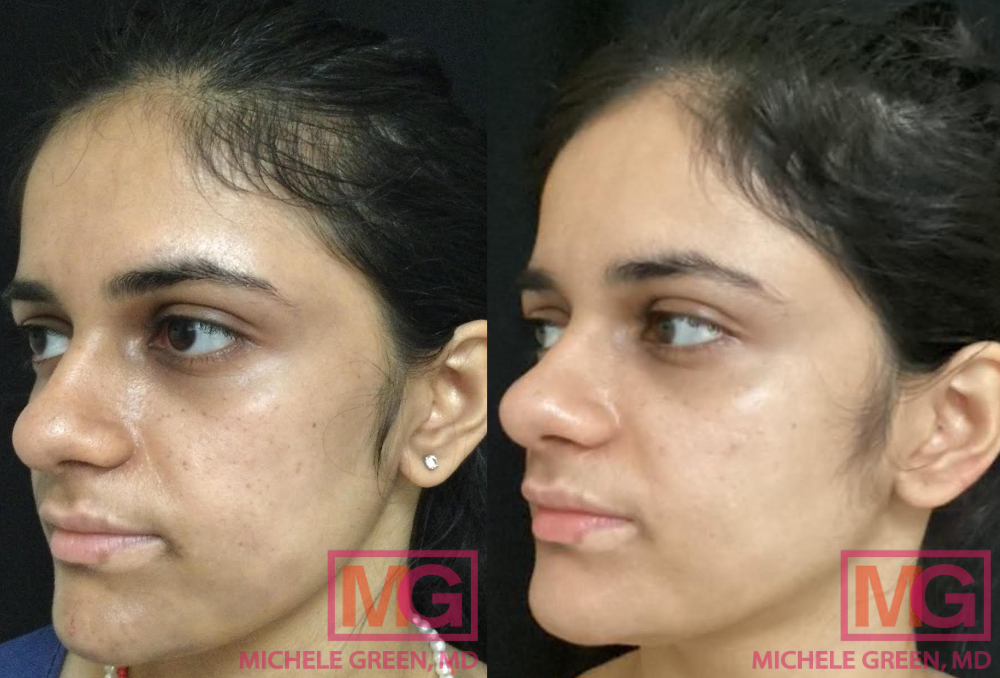
Before and after Cosmelan Treatment
Genetic predisposition and facial hyperpigmentation
Individuals with darker skin tones are more prone to hyperpigmentation because they have higher levels of melanin, which determines skin tone. Skin tone is influenced by genetics, and specific genes regulate the overall amount of melanin produced by melanocytes. Some genes also play a role in determining the total number of melanocytes that an individual has. As we age and our skin changes over time, an individual’s genetic makeup may affect their likelihood of developing hyperpigmentation. There is a significant hereditary aspect to certain types of hyperpigmentation, such as melasma. About 50% of individuals affected by melasma report a family history of the condition, and numerous cases have documented identical twins developing melasma.
Acne lesions and other skin conditions that cause post-inflammatory hyperpigmentation
Post-inflammatory hyperpigmentation (PIH) refers to the dark spots that may be left behind after an acne lesion or other inflammatory skin conditions, such as eczema, dermatitis, or psoriasis. Wounds from abrasions or scars from injuries can also heal with discoloration. The color of the dark spots associated with post-inflammatory hyperpigmentation can vary, presenting as brown, black, red, pink, or purple patches of skin, depending on skin tone. During the skin’s natural healing process, there is a possibility that the skin cells involved in healing the area contribute to the overproduction of melanin, resulting in the development of hyperpigmented areas. For many people, the best treatment for their PIH is to prevent the conditions that cause skin inflammation. Although this type of hyperpigmentation can fade without treatment, it may take a long time to resolve. Many patients choose to seek treatment to achieve clear, even skin more quickly.
Hyperpigmentation secondary to medications
Certain prescription and over-the-counter medications may increase the risk of developing facial hyperpigmentation. Antipsychotics, anticonvulsants, antimalarial medications, and NSAIDs are among the various types of drugs that can affect skin tone. Birth control pills that alter hormone levels can indirectly trigger hyperpigmentation by modifying estrogen and progesterone levels. Medications like the antibiotics Doxycycline and Minocycline can increase photosensitivity, putting individuals at a higher risk for developing dark patches, sunspots, or macules on the skin. To determine whether the facial hyperpigmentation is a result of one of the medications you are taking, Dr. Green will review all your medications and gather your complete medical history.
Laser damage causing secondary hyperpigmentation
If laser treatment is applied to a skin tone that is not suitable for that specific type of laser, it may lead to skin discoloration and hyperpigmentation. Certain lasers can trigger an inflammatory reaction, resulting in increased melanocyte activity and heightened pigmentation. Moreover, if the energy (or heat) used is too intense for a particular skin tone or type, it can lead to excessive hyperpigmentation as well. Dr. Michele Green has treated and corrected countless patients who developed hyperpigmentation from the Fraxel, Picosure, and IPL lasers. Care must be taken when treating hyperpigmentation, especially in patients with darker skin tones, to prevent worsening the underlying condition.
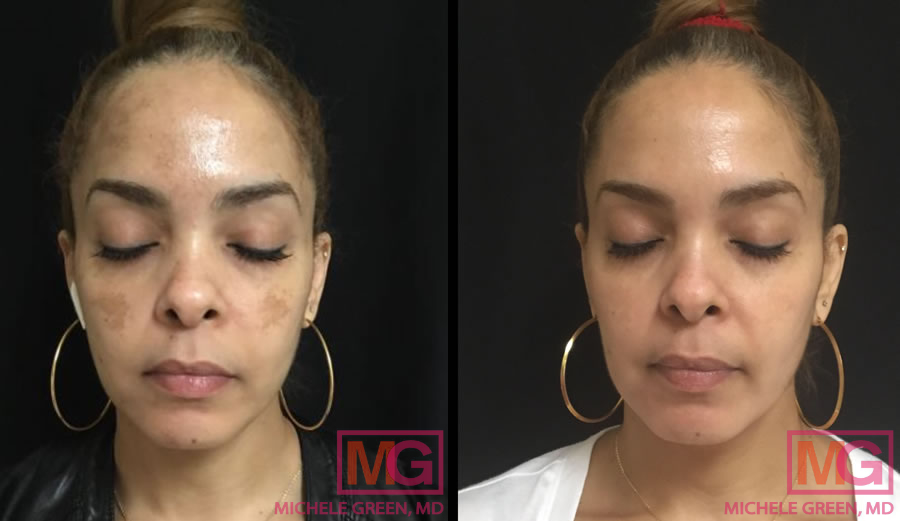
Female 35-44, Cosmelan, 2 & 1/2 months post treatment
Genetic predisposition causing hyperpigmentation
Individuals with darker skin tones are more prone to hyperpigmentation since they have more melanin, the component of skin that is responsible for producing your skin tone. Skin tone is affected by genes, and certain genes are involved in controlling the overall amount of melanin that is produced by melanocytes. Some genes play a role in determining the total number of melanocytes any individual has. As we age and the skin starts to change over time, the genetic makeup of an individual may make one more or less likely to become hyperpigmented. There is a strong hereditary component to certain forms of hyperpigmentation, such as melasma. Approximately 50% of individuals suffering from melasma report a positive family history of the condition, and many identical twins have been reported to develop melasma.
Acne lesions and other skin conditions that cause post-inflammatory hyperpigmentation
Post-inflammatory hyperpigmentation (PIH) refers to the dark spots that may be left behind after an acne lesion or other inflammatory skin condition such as eczema, dermatitis, or psoriasis. Wounds from abrasions or scars from an injury can also heal with discoloration. The color of the dark spots associated with post-inflammatory hyperpigmentation can vary from brown, black, red, pink, or purple patches of skin, depending on skin tone. During the natural healing process of the skin, there is potential that skin cells involved with healing the area are also contributing to the overproduction of melanin, leading to the development of hyperpigmented areas of skin. Although this type of hyperpigmentation may fade over time, it’s more effective and efficient to have treatment with a board-certified dermatologist like Dr. Green in New York. She can help guide you with the best skin care, sun protection, and skin-lightening products.
Hyperpigmentation secondary to medications
Certain prescription and over-the-counter medications may increase the risk of developing facial hyperpigmentation. Antipsychotics, anticonvulsants, antimalarial medicines, and NSAIDS are among some of the different groups of medications that can impact skin tone. Different medications may lead to hyperpigmentation through varying mechanisms. Some medications cause melanin to accumulate in the skin, causing hyperpigmentation. To determine whether the facial hyperpigmentation is related to medications, a thorough investigation of your medical history will take place during your consultation with Dr. Green.
Laser damage causing secondary hyperpigmentation
If laser treatment is used on a skin tone that is not well suited for that specific type of laser, it can result in skin discoloration and hyperpigmentation. In addition, If the energy (or heat) used is too high for a particular skin tone or skin type, the result can be an excess of hyperpigmentation as well. Dr. Michele Green has treated and corrected hundreds of patients with resulting hyperpigmentation from the Fraxel, Picosure, and IPL laser. Special care must be taken when treating hyperpigmentation, especially in patients with darker skin tones, to avoid a worsening of the underlying condition.
Similarly, melasma is an underlying condition that can often worsen from laser treatments, such as IPL, Picosure®, or Fraxel® laser. These laser treatments can potentially exacerbate the patches of hyperpigmentation associated with melasma and make them more difficult to remove. For this reason, Dr. Green always develops treatment plans for melasma that rely on chemical peels, Cosmelan® peels, Mesopeels®, and topical skin-lightening treatments. Dr. Green uses a combination of products that are hydroquinone-based and some that are hydroquinone-free.
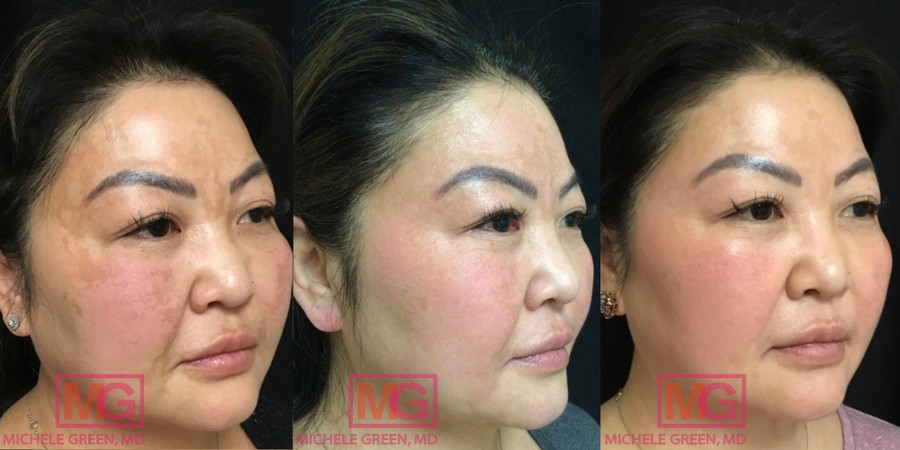
Treated with Cosmelan – 6 weeks
When should you consult a dermatologist for facial hyperpigmentation?
Hyperpigmentation can be a distressing sign of aging for many people, and navigating through the numerous treatment options available can be challenging. Furthermore, any new dark spots that appear should always be assessed by a board-certified dermatologist like Dr. Michele Green in NYC, who can determine whether the new lesion is benign or indicative of skin cancer. Consulting Dr. Green early during the stages of hyperpigmentation makes it less likely to become deeply entrenched in your skin, thereby facilitating easier removal. Dr. Green can identify the cause of your hyperpigmentation and recommend the best cosmetic treatment. During your consultation, she will suggest various options, including chemical peels, skin resurfacing lasers, Cosmelan peels, mesopeels, and topical skin-lightening agents. She will help you determine the most suitable cosmetic treatment for your skin tone and lifestyle to achieve beautiful, clear skin skin.
How to reduce pigmentation on the face:
There are several treatment options available for different types of facial hyperpigmentation. During a consultation with board-certified dermatologist Dr. Michele Green, the appropriate treatment will be determined based on your medical history, previous cosmetic treatments, skin type, and the specific dark spots you’re experiencing. Dr. Green utilizes laser therapies, chemical peels, in-office procedures, and topical products to lighten hyperpigmentation. She will advise you and create the optimal treatment schedule for your needs.
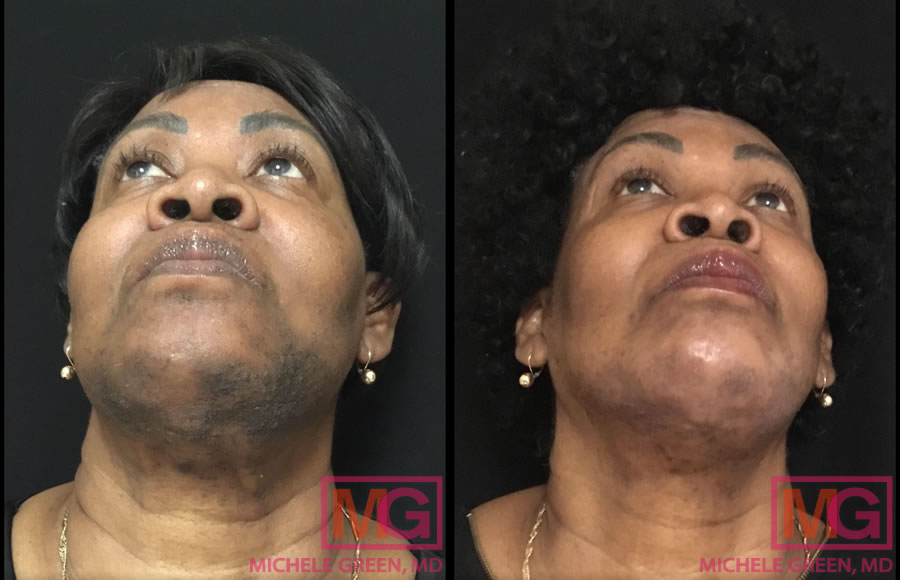
Chemical peel – 2 months before and after
AlexTrivantage Laser to remove Sunspots
Candela’s AlexTrivantage laser is used in Dr. Green’s NYC dermatology office to reduce the appearance of unwanted age spots, sun spots, freckles, and birthmarks. This laser effectively eliminates pigmented lesions with minimal discomfort and a short recovery time. During the procedure, it emits wavelengths of light that penetrate the dermis, where they are absorbed by melanin-rich skin cells. The light energy is then transformed into heat, destroying the pigmentation and allowing healthier, lighter skin cells to emerge. This laser specifically targets pigmented cells while leaving the surrounding skin unharmed—the effects of the treatment become visible one to two weeks after the procedure. Depending on the darkness of the sunspot, you may require one to two treatments to eliminate the discoloration and unwanted pigmentation. If a second treatment is necessary, a one-month interval is needed for complete healing between sessions sessions.
Fraxel Laser treatment for hyperpigmentation and sun spots
The Fraxel laser is known as the “Magic Eraser” and is the gold standard treatment for improving skin tone and texture. Fraxel is a fractionated skin resurfacing procedure often recommended for patients suffering from extensive sun damage and facial hyperpigmentation. It can effectively reduce the appearance of dark sunspots across the face, neck, chest, arms, or legs with minimal downtime. The Fraxel laser operates at two wavelengths: 1927nm, which targets pigmentation and sun spots (age spots), and 1550nm, which addresses fine lines, wrinkles, and acne scars. The laser creates controlled, microscopic wounds in the skin using highly concentrated pulses of light.
As the skin repairs these wounds, new collagen forms, new skin cells develop, and sun damage begins to heal, revealing a brighter, more radiant complexion that is uniform in tone. Using the 1927nm wavelength setting, the Fraxel laser targets and destroys melanin in pigmented cells while leaving the surrounding skin untouched. For this reason, Fraxel lasers are best suited for patients with lighter skin (Fitzpatrick Skin Types I-III) to avoid unnecessary side effects in individuals with darker skin tones. Most patients seeking treatment for sun damage and age spots with Fraxel require multiple sessions spaced one month apart to achieve optimal cosmetic results.
Clear + Brilliant® Laser
The Clear + Brilliant Laser is a gentle laser treatment that utilizes fractional laser technology to target facial hyperpigmentation and fine lines, reduce pore size, and enhance the overall appearance of skin tone and texture. Often referred to as the “mini-Fraxel,” it effectively addresses a variety of skin concerns. With the Clear + Brilliant Laser treatment, patients can anticipate skin rejuvenation and a decrease in pigmentation, as the laser’s fractionated energy precisely targets melanin-rich lesions and stimulates collagen production for healthier, new skin. The Clear + Brilliant Laser treatment is suitable for all skin types and tones, and no downtime is required after the procedure.
Intense Pulsed Light for sun damage
Intense Pulsed Light (IPL) is an effective treatment for eliminating facial hyperpigmentation and dark spots while enhancing the overall appearance of your skin. Unlike other lasers that typically emit a single wavelength, IPL utilizes multiple wavelengths of light. This feature enables IPL to address a wider range of skin issues. Depending on the specific wavelength, IPL can target hyperpigmented skin cells, hair follicles (for hair removal), or facial rosacea (broken blood vessels) and promote new collagen formation for skin tightening. In the treatment of hyperpigmentation, the pigment cells in the dermis absorb the light energy from IPL and are destroyed, leaving the surrounding cells unharmed. For optimal cosmetic results, five treatment sessions spaced one month apart are typically recommended.
VBeam laser for melasma
It is considered the gold standard for treating facial erythema, which is commonly known as facial redness. This condition can result from skin issues like rosacea or post-inflammatory hyperpigmentation (PIH) and may also be associated with broken blood vessels. The laser works by emitting a burst of light at a wavelength of 595 nanometers, specifically targeting the red pigment in blood vessels. The emitted energy converts to heat in the skin and is absorbed by the chromophores that determine color. Consequently, the VBeam laser does not affect other areas of the skin and effectively addresses the redness experienced by patients. Typically, four to six laser treatments are sufficient to reduce inflammation from melasma and other hyperpigmentation disorders.
The Cosmelan Peel
The Cosmelan peel is a professional-grade treatment that Dr. Green frequently uses to address melasma. In the first step, Dr. Green applies the Cosmelan peel product to the skin in her Upper East Side Manhattan office, where it is worn for several hours (the duration depends on your skin tone and the severity of hyperpigmentation). Following this, a strict regimen of specially formulated creams must be adhered to in order to reduce hyperpigmentation or melasma further. These creams include hydroquinone, vitamin K, sunscreen, and a uniquely formulated Cosmelan 2 product. The Cosmelan peel works through various mechanisms to effectively diminish the overall appearance of melasma. It reduces melanin production (which is responsible for skin pigment) within the melanocytes (the skin cells that produce melanin) by inhibiting the tyrosinase enzyme. Additionally, it blocks the transfer of melanin from the melanocyte to the keratinocyte, preventing the migration of pigment to the epidermal layer of the skin. Dr. Green schedules follow-up appointments for her patients in four weeks to monitor treatment progress, at which time she may apply the mask a second time if needed on certain areas of the face. Patients have reported excellent results from the Cosmelan peel, and for many, it is the only solution that has effectively treated their melasma.
Mesopeels for body and facial hyperpigmentation
Mesopeels are specially formulated chemical peels designed to target various types of hyperpigmentation, fade dark spots, and reduce melanocyte activity. They gently yet effectively diminish the overall appearance of skin discoloration and dark spots. Dr. Green commonly uses mesopeels to treat patients concerned about facial hyperpigmentation in sensitive areas where traditional chemical peels may be too irritating. In addition to the face, mesopeels are effective for many delicate body areas, such as the axillae (armpits), groin, inner thighs, and under-eye regions, which are also too sensitive for traditional chemical peels. Their formulation includes azelaic acid, resorcinol, phytic acid, and tranexamic acid, all scientifically proven skin-lightening ingredients. Mesopeels stimulate new collagen and elastin production due to chemo-exfoliation, resulting in brighter and healthier-looking skin. One of the key advantages of mesopeels is that no recovery time is required with this special type of chemical peel.
Chemical peels for facial hyperpigmentation
Chemical peels are resurfacing treatments designed to exfoliate the top layer of the skin, accelerating skin cell turnover and stimulating new collagen production, which enhances overall skin tone and texture. They are classified as superficial (or light), medium depth, and deep. Generally, the most effective chemical peels for hyperpigmentation contain trichloroacetic acid (TCA). TCA peels are ideal for improving skin tone and texture, addressing concerns such as fine lines, acne scars, active acne, enlarged pores, hyperpigmentation, and other signs of aging. A series of three to six chemical peels is typically recommended, depending on the severity of the hyperpigmentation. However, TCA peels are not advised for patients with darker skin tones, as they are at a higher risk of post-peel discoloration and hypopigmentation.
Microneedling with depigmentation serum to improve facial hyperpigmentation
Microneedling is a non-invasive procedure that uses surgical-grade needles to create microscopic injuries in the skin. This technique stimulates the body’s natural healing process, promoting the production of new collagen and elastin. By enhancing collagen and elastin production, microneedling helps to improve skin tone and texture while also reducing the appearance of fine lines and wrinkles. For patients with facial hyperpigmentation, the treatment can be enhanced with a special depigmentation serum to target post-inflammatory hyperpigmentation (PIH) and dark spots from acne scars. The micro-channels created by the procedure allow for better absorption of the depigmentation serum, improving areas of discoloration and lightening the skin. The serum contains a unique blend of effective yet gentle skin-brightening agents that inhibit melanocyte activity. Microneedling with depigmentation serum is safe for all skin types and requires no downtime after treatment.
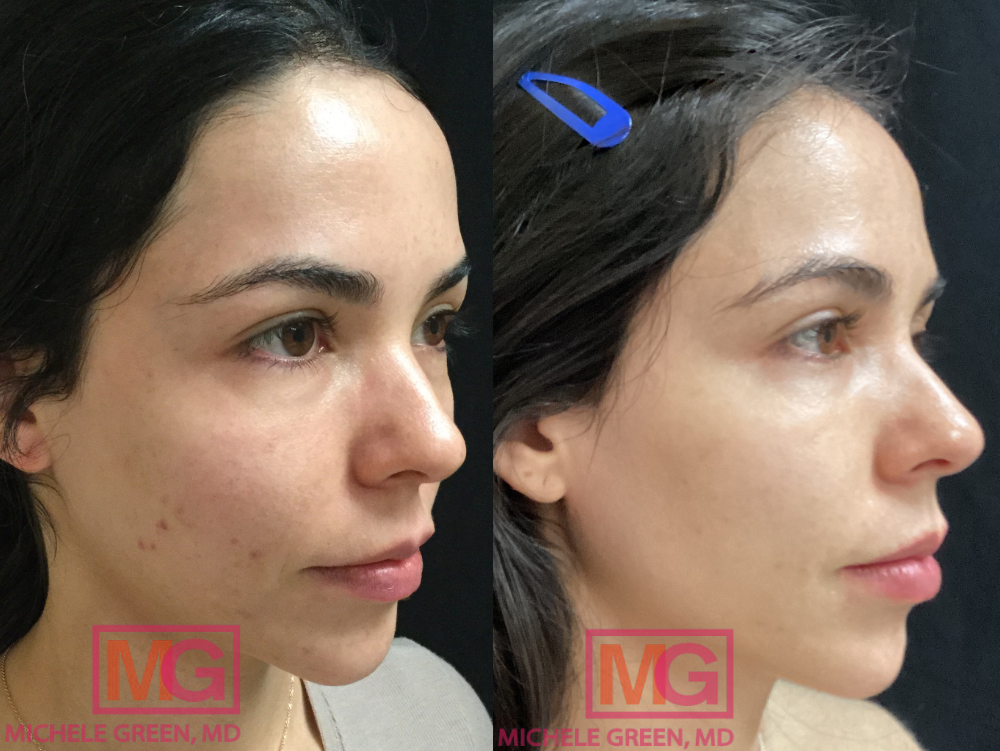
HydraFacials to reduce pigmentation
The HydraFacial is a three-step medical-grade facial designed to enhance the overall appearance and texture of the skin. It focuses on deeply cleansing, gently exfoliating, and intensely nourishing the skin. Utilizing unique vortex fusion technology, the HydraFacial allows for the efficient extraction of impurities from the pores while simultaneously infusing beneficial antioxidants into the skin. The result is a radiant and healthy glow achieved in just one thirty-minute treatment, with no downtime required. This procedure can be enhanced with booster serums that target specific skin concerns, such as hyperpigmentation. Customizing your HydraFacial with a Brighten booster can further improve your complexion and brighten your skin tone in the evening. The Brighten booster is formulated with antioxidants and skin-brightening ingredients that minimize dark spots and balance skin tone. Another excellent option is the Murad Vita-C booster, which contains vitamin C, glycolic acid, tranexamic acid, and a patented RepleniCell compound to brighten the skin.
Topical skincare products and sunscreen
Several topical treatments, including hydroquinone, retinol, vitamin C, and sunscreen, can help address facial hyperpigmentation.
Hydroquinone is the gold standard ingredient in many skin-lightening creams. Currently, no hydroquinone-based creams are available for purchase over the counter. Dr. Michele Green can prescribe hydroquinone-based skin-lightening creams that contain 4 percent concentration or more. Hydroquinone works to eliminate excess melanin production and reduce melanocyte activity. This topical treatment should be used with caution, as patients may experience irritation during use. Special care is needed since hydroquinone increases skin sensitivity to the sun, making sun avoidance essential to prevent exogenous ochronosis.
Dr. Green also utilizes the vitamin A derivatives retinol and retinoids to treat facial hyperpigmentation. Retinol is found in various over-the-counter skincare products, while dermatologists like Dr. Green prescribe retinoids, such as tretinoin. Both retinol and retinoids encourage skin cell turnover and boost collagen production, leading to a smoother, more even-toned complexion overall. It is important to note that not everyone can tolerate prescription-strength retinoids. Discontinuing use is crucial if any skin irritation occurs, as continued use can cause skin damage and worsen pigmentation. Furthermore, patients must practice adequate sun protection, as retinol and retinoids heighten the skin’s sensitivity to sunlight.
Dr. Green has developed a proprietary line of skincare products known as MGSKINLABs Inc. These products aim to target hyperpigmentation and lighten the skin, including Skinbright RX cream. The Skinbright cream is free from hydroquinone and contains natural skin-lightening ingredients such as niacinamide and kojic acid, which help to reduce hyperpigmentation and gently brighten the skin. Another popular product in the MGSKINLABS line is the Vita-C Serum. As a potent antioxidant, vitamin C combats the damaging effects of free radicals that contribute to premature skin aging. Additionally, vitamin C helps to diminish the appearance of hyperpigmentation by inhibiting melanin production in the skin, enhancing the overall complexion. It also supports collagen synthesis, a protein that provides structural support and contributes to a youthful, supple appearance. By promoting skin cell regeneration and stimulating collagen production, vitamin C improves the skin’s texture and tone.
Sun protection is a lifelong priority for individuals with facial hyperpigmentation. Sun exposure has the potential to exacerbate the appearance of hyperpigmentation. Melanocytes, the skin cells responsible for melanin production and skin pigment, can be retriggered by sun exposure. This means that excess melanin is likely to be reproduced and the excess pigmentation returned if triggered by the sun, even if the skin has been treated for hyperpigmentation in the past. To prevent this, select a sunscreen that offers broad-spectrum coverage, protecting against both UVA and UVB rays. If your skin is prone to pigmentation or melasma, it is best to layer sunscreens for optimal protection. It is vital to apply a chemical sunblock first to your face. After the sunscreen penetrates, apply a layer of physical sunblock containing zinc oxide. By layering these two different types of sunblocks, your skin will have the best protection against sun exposure and the least chance of developing sun damage or hyperpigmentation.
How much does facial hyperpigmentation treatment cost?
The total cost of treating facial hyperpigmentation varies based on a variety of factors. The severity of the hyperpigmentation and the selected treatment method (skin-lightening products, chemical peels, laser treatments, or a unique combination of approaches) play key roles in determining the cost, as deeper hyperpigmentation often necessitates more extensive treatment. Additionally, the experience of your treating physician and your geographic location can influence the overall cost. A board-certified dermatologist like Dr. Michele Green, who specializes in the treatment of melasma and hyperpigmentation, typically charges more than a nurse at a medspa.
When addressing your hyperpigmentation, it is crucial to choose a board-certified cosmetic dermatologist, such as Dr. Michele Green in New York, who possesses the experience and expertise to help you achieve optimal cosmetic results. Improper treatment of facial hyperpigmentation can exacerbate the issue, making it more difficult to eliminate. Treatments like the Fraxel laser, IPL, or Picosure can potentially worsen melasma and complicate the removal of facial hyperpigmentation. Dr. Green, a board-certified cosmetic dermatologist with over 25 years of experience in treating melasma and pigmentation disorders, utilizes the finest skincare, chemical peels, and laser treatments. During a consultation, Dr. Green will identify the most suitable cosmetic treatment for your specific type of facial hyperpigmentation and skin tone and review the overall cost.
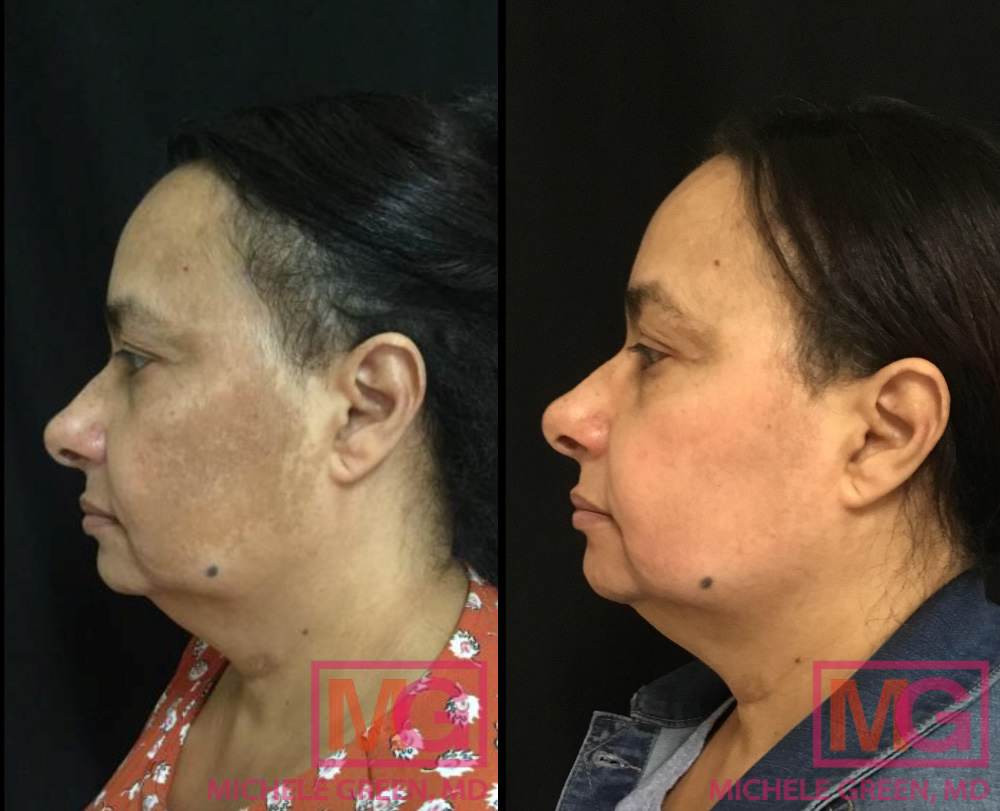
Cosmelan – 8 months before and after
Frequently Asked Questions & Answers
What is hyperpigmentation on the face?
Many factors contribute to hyperpigmentation, including genetics, sun exposure, and hormonal fluctuations. The primary cause of hyperpigmentation is sun exposure. As your body works to protect itself from the sun’s harmful UV rays, it produces more melanin. Melanin is the pigment that gives our skin, hair, and eyes their color. However, when it is overproduced in certain areas but not others, it can lead to hyperpigmentation. Melanin production is stimulated during sun exposure to shield the skin. In some instances, the melanocytes within the skin become overactive, resulting in hyperpigmentation. Melasma is often genetic and is significantly more common in women than in men. Over 50 percent of patients report a positive family history of melasma. One reason women are more prone to melasma is that estrogen and progesterone are linked to melanin production. Elevated levels of these two sex hormones are typical during puberty, pregnancy, and menopause, contributing to a greater likelihood of women developing hyperpigmentation.
How to treat dark spots on the face?
A common question in Dr. Green’s boutique dermatology office is, “How can I remove the dark spots on my face?” There are numerous ways to address dark spots, from the Alextrivantage laser, which is excellent for treating sunspots, to the Cosmelan peel, which is ideal for facial melasma. When you consult with Dr. Michele Green in her private dermatology office, she will gather your complete medical history and evaluate your dark spots to determine the best treatment or combination of treatments for you.
How to clear dark spots on your face?
Dark spots on the face can be frustrating, and many patients seek ways to eliminate them. Fortunately, Dr. Michele Green in NYC is available to assist. Patients with sunspots caused by UV light exposure may benefit from laser treatments such as the AlexTrivantage or Fraxel lasers. Conversely, patients with melasma, who should avoid laser treatments that could exacerbate their pigmentation, can opt for chemical peels like the Cosmelan Peel or Mesopeel. During your consultation, Dr. Green will assess your dark spots and identify which treatment or combination of treatments is best for you, including lasers, topical prescriptions, and skincare products.
Will hyperpigmentation fade?
Sperpigmentation will lighten over time without treatment, while other forms may not resolve on their own. Typically, more superficial pigmentation in the epidermis fades faster than deeper pigmentation. Post-inflammatory hyperpigmentation (PIH) begins to fade once the acne or rash causing the skin damage has resolved. To speed up the healing process, patients with PIH can use topical treatments like salicylic acid and glycolic acid intermittently to help gently increase cell turnover. If you have hyperpigmentation you’d like to fade, the first step is to schedule a consultation with Dr. Michele Green in NYC. Dr. Green will assess your discoloration and develop a personalized treatment plan that will safely and effectively lighten your dark spots.
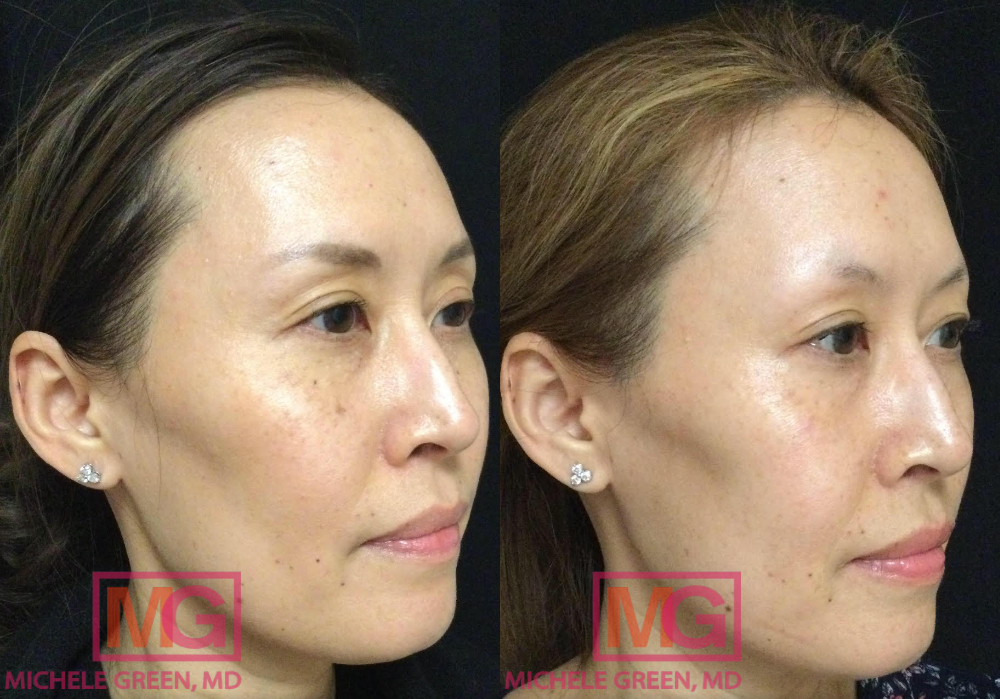
Can facial hyperpigmentation return after it has been treated?
Hyperpigmentation can return after treatment. Melanocytes, the skin cells that produce melanin, have a memory. Hyperpigmentation occurs when our skin cells absorb UV radiation, leading to mutations and long-term damage that persists even after therapy. Any further sun exposure following hyperpigmentation treatment can cause it to reappear. For this reason, the importance of sun protection for individuals who have experienced or currently experience facial hyperpigmentation cannot be overstated. To maintain the cosmetic results of hyperpigmentation treatment, always remember to use a broad-spectrum sunscreen with a minimum SPF of 50, reapply generously, and wear protective clothing such as a hat and sunglasses to shield your skin from the sun.
Treating facial hyperpigmentation in patients with dark skin tones
Dark skin tones can be sensitive to various treatments for hyperpigmentation, with a higher risk of developing hyperpigmentation after treatment. Generally, laser treatments such as the Fraxel laser, Picosure, and IPL often exacerbate melasma and hyperpigmentation in patients with darker skin. The hyperpigmentation resulting from laser treatments is usually more challenging to address than the original melasma. For patients of color, the most effective treatments include chemical peels, mesopeels, Cosmelan peels, and topical treatments. These products are suitable for all skin tones and can successfully treat melasma, sunspots, dark spots, and other pigmentation disorders without worsening the underlying skin condition. It is particularly important to find a board-certified dermatologist, like Dr. Green, who has extensive experience in treating patients of all skin tones.
How do you remove pigmentation from the face permanently?
The ability to permanently remove pigmentation varies from patient to patient, largely depending on the underlying cause of hyperpigmentation. The most crucial factor for achieving permanent pigmentation removal is sun protection. Hyperpigmentation can recur with additional sun exposure as the skin begins to produce more melanin. Even a brief period of sun exposure can lead to the return of previously treated hyperpigmentation and the formation of new spots over time. Once patients achieve clear, even skin, they must practice strict sun avoidance by using sunscreen and wearing sun-protective clothing. Patients with a history of hyperpigmentation should apply a broad-spectrum sunscreen with an SPF of 50 or higher. Often, using two types of sunscreen—a chemical sunscreen followed by a physical sunscreen—can provide even more comprehensive coverage protection.
How to remove dark spots on your face with home remedies
Many home remedies for removing dark spots on the face are largely anecdotal, and there haven’t been many clinical studies conducted to research their safety and effectiveness in treating pigmentation. Licorice oil is known for its anti-inflammatory properties and is thought to brighten the skin and diminish dark spots. However, the extent of these benefits has not been thoroughly researched. Aloe vera gel is a popular home remedy applied to pigmented areas at night and washed off the next morning. Several clinical studies have suggested that aloe vera may assist with pigmentation because it contains aloin, a compound that can break down melanin and aloesin, which inhibits tyrosinase and prevents melanin production. Some research has shown that green tea extract and turmeric can help treat melasma and hyperpigmentation due to their antioxidant properties. It is crucial to note that while home remedies may be “natural,” they can also cause irritation and inflammation of the skin. If you’re considering using any natural or home remedies to treat dark spots on your face, consult with a board-certified dermatologist, such as Dr. Michele Green in NYC, who can guide you toward safe and effective dark spot removal treatment.
How to remove dark spots from your face overnight?
Currently, there are no topical or in-office treatments available to eliminate dark spots overnight, and all existing treatments require time to take effect. Topical products gradually fade dark spots, and it may take months to achieve the desired cosmetic results. In-office treatments, such as chemical peels, laser therapies, and microneedling, usually necessitate a series of sessions for dark spot removal but provide faster results compared to topical treatments alone. If you are eager to have your dark spots removed as quickly as possible, consult Dr. Michele Green in her private Upper East Side office for a treatment plan tailored to your skin type and tone. In her dermatology practice, Dr. Green employs various minimally invasive cosmetic procedures and prescription products to lighten dark spots, helping patients achieve brighter, more even skin tones skin.
How to remove dark spots from your face instantly?
Many patients in Dr. Green’s office wonder, “How can I quickly remove dark spots from my face?” Unfortunately, no treatment will instantly eliminate dark spots; instead, effective treatments for removing dark spots require time. If you have dark spots and want to address your facial hyperpigmentation, the first step is to consult with Dr. Michele Green, who will create a tailored treatment plan to help you achieve a clear, even skin tone as quickly as possible. Depending on the type and depth of the pigmentation, Dr. Green may recommend laser treatments, chemical peels, topical creams, or a unique combination of therapies that will reduce your hyperpigmentation.
How do you eliminate pigmentation on the face?
There are many different treatment options available to improve facial hyperpigmentation. Topical skin lightening products, chemical peels, Cosmelan peels, Mesopeels, HydraFacials, Fraxel laser, Clear + Brilliant laser, and AlexTrivantage laser are just a few of Dr. Green’s preferred methods for addressing dark patches on the skin caused by hyperpigmentation. Ultimately, the appropriate treatment for your hyperpigmentation will depend on your skin type, skin tone, and the specific type of hyperpigmentation you have. The first step in eliminating facial pigmentation is to consult with a board-certified cosmetic dermatologist, such as Dr. Green, in the Upper East Side of NYC. Incorrect treatment for hyperpigmentation can exacerbate the issue, making it even more difficult to eliminate. Laser treatments are generally unsafe for patients with melasma and may lead to additional hyperpigmentation. During a consultation with Dr. Green, a personalized treatment plan for your specific type of facial hyperpigmentation will be developed.
How to get rid of hyperpigmentation
Facial hyperpigmentation and discoloration can stem from various factors, such as excessive sun exposure, aging, inflammatory acne, and hormonal changes. It can affect individuals of all ages and skin tones, often impacting self-esteem. Fortunately, a range of non-invasive cosmetic procedures and topical skin care products are available to treat and improve the appearance of hyperpigmentation. These treatments can be combined to achieve clear, beautiful skin. Whether it involves skin resurfacing lasers, chemical peels, microneedling, or specific topical products, Dr. Michele Green in NYC can create a personalized treatment plan to reduce your facial hyperpigmentation.
Dr. Michele Green is a world-renowned expert in cosmetic dermatology, boasting over 25 years of experience treating various types of facial hyperpigmentation in the world’s most discerning men and women. She has consistently been voted one of the best cosmetic dermatologists in NYC by Castle Connolly, The New York Times, New York Magazine, and Super Doctors, thanks to her expertise and dedication to her patients. An expert in both cosmetic and medical procedures such as dermal fillers and skin biopsies, Dr. Green tailors each patient’s treatment plan to meet their specific needs and goals. If you are struggling with melasma, post-inflammatory hyperpigmentation, sun spots, sun damage, or other forms of hyperpigmentation, Dr. Green is ready to help. To schedule a consultation for your facial hyperpigmentation, please contact us online today or call our New York City-based office at 212-535-3088.
Related Topics
- Find out about sun spot removal
- Find out more about additional acne scar removal with microdermabrasion
- Melasma treatments with Cosmelan
- Treat brown spots with the Candela AlexTriVantage Laser
- Fraxel Laser Treatment
- More info about causes of Melasma
- Additional Info on Melasma & Hyperpigmentation
- Laser Treatment for Dark Spots
- What is the Melasma Mustache
- Skin Discoloration Treatment
- Skin Lightening for Intimate Areas
 212-535-3088
212-535-3088